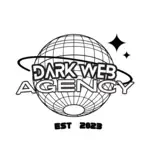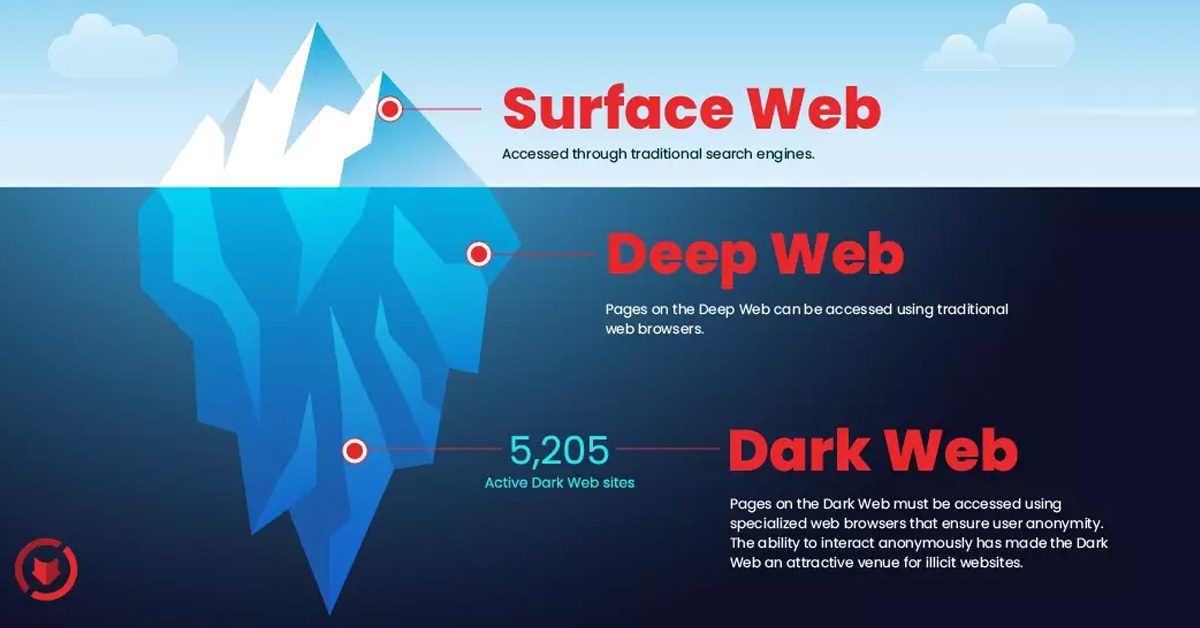
Dark web definition
The dark web refers to a clandestine network of internet sites that can only be accessed through a specialized web browser. It serves as a means to maintain anonymity and privacy in online activities, catering to a spectrum of applications, both lawful and unlawful. While some individuals leverage the dark web to circumvent government censorship, it has gained notoriety for its association with illicit activities.
What is the dark web, deep web, and surface web?
The Internet is vast, hosting millions of web pages, databases, and servers that operate around the clock. However, the portion known as the “visible” Internet, also referred to as the surface web or open web, consists of sites easily discoverable through search engines like Google and Yahoo. It’s essential to understand various terms associated with the non-visible web if you intend to explore beyond the commonly known areas.
The surface web or open web
The open web, also known as the surface web, constitutes the visible surface layer of the internet. If we envision the entire web as an iceberg, the open web corresponds to the top portion that is above the water. In terms of statistics, this segment of websites and data represents less than 5% of the total internet.
Commonly accessed through traditional browsers such as Google Chrome, Internet Explorer, and Firefox, the open web encompasses websites labeled with registry operators like “.com” and “.org.” These sites can be easily discovered using popular search engines.
The visibility of surface web websites is facilitated by search engines that index the web through visible links, a process known as “crawling” as the search engine traverses the web akin to a spider.
The deep web
The deep web, constituting about 90% of all websites, lies beneath the surface, analogous to the submerged part of an iceberg that surpasses the surface web in size. The enormity of this hidden web makes it impossible to ascertain the exact number of active pages or websites at any given time.
In this analogy, major search engines can be likened to fishing boats capable of “catching” websites close to the surface, leaving everything else, including academic journals, private databases, and more illicit content, beyond their reach. The deep web also encompasses what is commonly known as the dark web.
While media outlets often use “deep web” and “dark web” interchangeably, a significant portion of the deep web is entirely legal and secure. Some substantial components of the deep web include:
- Databases: Collections of public and privately protected files that are not interconnected with other web areas and can only be searched within the database itself.
- Intranets: Internal networks for enterprises, governments, and educational institutions used for private communication and control within their organizations.
For those wondering how to access the deep web, it is likely that they already use it daily. The term “deep web” refers to all web pages unidentifiable by search engines, concealed behind passwords or security measures that prevent search engines from crawling them. These pages, lacking visible links, remain hidden for various reasons.
On the larger deep web, the “hidden” content is generally safe and clean. This includes blog posts in-review, pending web page redesigns, and pages accessed during online banking, posing no threat to computer or overall safety. Pages in this category are kept hidden from the open web to safeguard user information and privacy, encompassing:
- Financial accounts (banking and retirement)
- Email and social messaging accounts
- Private enterprise databases
- HIPAA-sensitive medical information
- Legal files
Venturing further into the deep web introduces some risks. Some users explore portions of the deep web to bypass local restrictions and access unavailable TV or movie services, while others engage in downloading pirated music or acquiring unreleased movies.
At the dark end of the web lies more hazardous content and activities. Tor websites, located in this far end of the deep web, constitute the “dark web” and are accessible only through an anonymous browser.
Deep web safety is more pertinent to the average internet user than dark web safety, as accidental navigation through tangential pathways can lead to dangerous areas. Many parts of the deep web can still be accessed through normal internet browsers, potentially exposing users to piracy sites, politically radical forums, or disturbingly violent content.
The dark web
The dark web, constituting sites that are not indexed and accessible only through specialized web browsers, is considerably smaller than the surface web and is regarded as part of the deep web. Using the ocean and iceberg analogy, the dark web can be likened to the bottom tip of the submerged iceberg.
This concealed section of the deep web is rarely interacted with or seen by most users. Essentially, the deep web encompasses everything beneath the surface that remains accessible with the right software, incorporating the dark web.
Breaking down the construction of the dark web reveals key layers that contribute to its anonymity:
- Lack of webpage indexing by surface web search engines: Popular search tools like Google cannot discover or display results for pages within the dark web.
- “Virtual traffic tunnels” through a randomized network infrastructure.
- Inaccessibility by traditional browsers due to a unique registry operator, further obscured by network security measures such as firewalls and encryption.
The dark web has often been associated with criminal intent or illegal content, including “trading” sites where users can purchase illicit goods or services. However, legal entities have also utilized this framework.
Regarding dark web safety, the dangers of the deep web differ from those of the dark web. Illegal cyber activities may not be easily encountered but can be more extreme and threatening if actively sought out. Before delving into the threats of the dark web, it’s essential to explore how and why users access these sites.
Types of Threats on the Dark Web: Understanding the Dangers
The dark web, known for its hidden nature and anonymity, poses various threats to users who venture into its depths. Whether considering the potential dangers of malicious software, government monitoring, or scams, it’s crucial to be aware of the risks associated with exploring this obscure realm. Here are some common threats individuals may encounter while navigating the dark web:
- Malicious Software:
- Keyloggers: Malware that records keystrokes, potentially compromising sensitive information.
- Botnet Malware: Software used to control a network of compromised computers, often for malicious purposes.
- Ransomware: Malware that encrypts files, demanding payment for their release.
- Phishing Malware: Malicious software designed to trick users into revealing personal information.
- Government Monitoring:
- Authorities may monitor Tor-based sites, making visitors potential targets for government surveillance.
- Dark websites, even those seemingly innocuous, could be subject to police takeover, jeopardizing user identities.
- Scams:
- Alleged services, such as “hitmen” offerings, may turn out to be scams aimed at profiting from unsuspecting customers.
- Scams exploiting the dark web’s reputation may trick users into significant financial losses.
- Phishing scams may attempt to steal user identities for extortion purposes.
End-User Protection Against Exploitation by the Dark Web: Safeguarding Your Digital Presence
Whether an individual, business, or parent, taking precautions is vital to prevent personal information from being misused on the dark web. Here are some measures to protect against exploitation:
- Identity Theft Monitoring:
- Regular monitoring of identity for potential misuse.
- Utilizing online security services that offer identity protection.
- Antimalware and Antivirus Protections:
- Employing robust antimalware and antivirus programs.
- Utilizing comprehensive endpoint security solutions for both identity monitoring and defense against malware.
How to Access the Dark Web Safely: Tips for Safe Exploration
If there is a legitimate need to access the dark web, individuals should prioritize safety. Here are seven tips for safe access to the dark web:
- Trust Your Intuition:
- Be cautious and attentive to your instincts.
- Remove yourself from situations that feel unsafe or suspicious.
- Detach Online Persona from Real Life:
- Use unique usernames, email addresses, and passwords.
- Avoid using any information that can identify you online or offline.
- Monitor Identity and Financial Protection:
- Utilize tools provided by online security services for identity protection.
- Avoid Dark Web File Downloads:
- Fear of malware infection is higher on the dark web.
- Employ real-time file scanning to check any incoming files.
- Disable ActiveX and Java:
- Minimize security risks by disabling ActiveX and Java in network settings.
- Use a Secondary Non-Admin Account:
- Limit account privileges to impede malware exploitation.
- Restrict Access to Tor-Enabled Devices:
- Protect family members, especially children, from inappropriate content.
- Exercise caution and responsibility when exploring the dark web.
By following these tips, individuals can enhance their safety while navigating the dark web, mitigating potential risks associated with this hidden corner of the internet.


Najdete dark web smysl na hodnocení produktu které zde zanechávají draci kteří postupují v prostoru blíž a blíž..